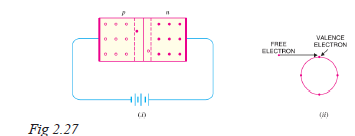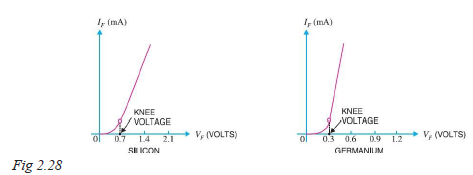1. Breakdown voltage: It is the minimum reverse voltage at which pn junction breaks down with sudden rise in reverse current.
- Under normal reverse voltage, a very little reverse current flows through a pn junction. However, if the reverse voltage attains a high value, the junction may break down with sudden rise in reverse current. For understanding this point, refer to Fig. 2.27. Even at room temperature, some hole-electron pairs (minority carriers) are produced in the depletion layer as shown in Fig. 2.27 (i).
- With reverse bias, the electrons move towards the positive terminal of supply. At large reverse voltage, these electrons acquire high enough velocities to dislodge valence electrons from semiconductor atoms as shown in Fig. 2.27 (ii). The newly liberated electrons in turn free other valence electrons. In this way, we get an avalanche of free electrons. Therefore, the pn junction conducts a very large reverse current.
- Once the breakdown voltage is reached, the high reverse current may damage the junction. Therefore, care should be taken that reverse voltage across a pn junction is always less than the breakdown voltage.
 2. Knee voltage:
2. Knee voltage: It is the forward voltage at which the current through the junction starts to increase rapidly.
- When a diode is forward biased, it conducts current very slowly until we overcome the potential barrier. For silicon pn junction, potential barrier is 0.7 V whereas it is 0.3 V for germanium junction.
- It is clear from Fig. 2.28 that knee voltage for silicon diode is 0.7 V and 0.3 V for germanium diode. Once the applied forward voltage exceeds the knee voltage, the current starts increasing rapidly. It may be added here that in order to get useful current through a pn junction, the applied voltage must be more than the knee voltage.
Note: The potential barrier voltage is also known as turn-on voltage. This is obtained by taking the straight line portion of the forward characteristic and extending it back to the horizontal axis.

Wilfykil answered the question on
August 14, 2019 at 06:01